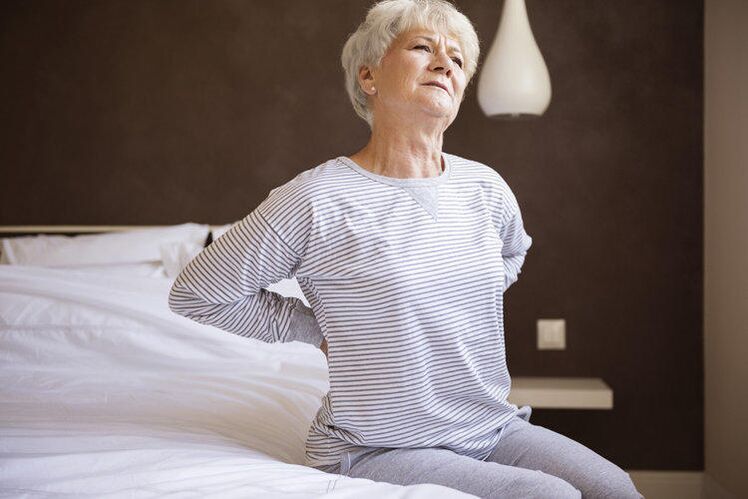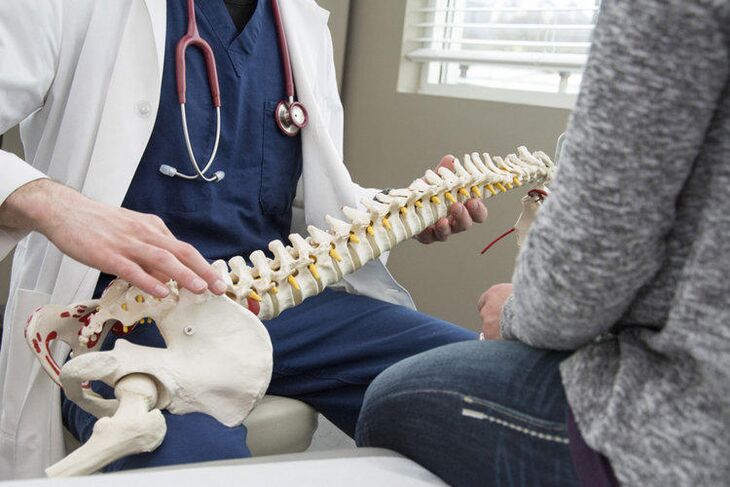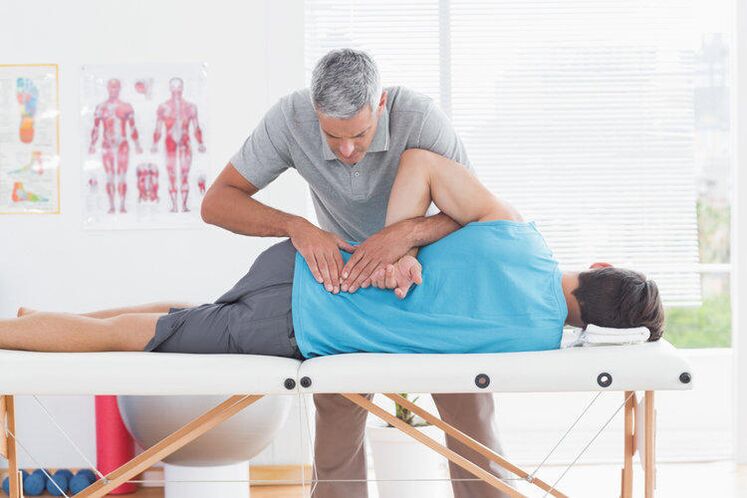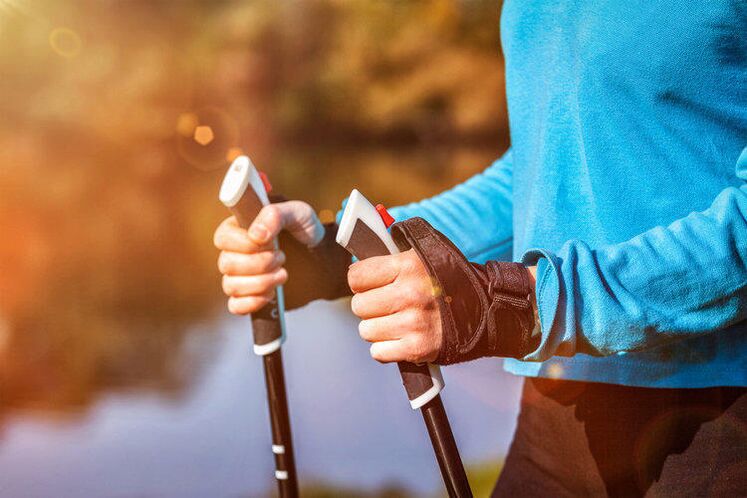Osteochondrosis is a disease in which degenerative-dystrophic changes are diagnosed in the cartilage tissue of the spine, also accompanied by disorders of the structure and functionality of the intervertebral discs. Depending on the location of damaged tissue, osteocondrosis is separated by cervical, thoracic and lumbar.

What is osteocondrosis?
Osteocondrosis is a spine disease where degenerative and dystrophic lesions of the intervertebral disks occur. With the development of osteochondrosis, degenerative-dystrophic lesions apply to back tissue.
The most important function that indicates the development of osteochondrosis is pain in the neck, back, lower back area, with progression, the pain "gives" in the hands, chest, shoulders, upper thighs, etc. With negative dynamics in osteochondrosis, atrophy of muscle tissue, decreased sensitivity, and dysfunction of the inner organ, testified their suppression, testing, testing, testing, testing, testing, testing, testing, testing, testing, testing, testing, testing, testing, sample, Testing, provocation that is performed. displacement. In the absence of timely therapy, osteochondrosis develops into an incurable state.
The causes of osteocondrosis
The main factor in the development of osteochondrosis is an uneven load on the spine. The habit of carrying a bag on a shoulder or in one hand, a wrong position in a sitting position, a dream on an excessively soft mattress, a high cushion that wearing anatomically wrong types of shoes is a common cause of incorrect distribution of load.
Additional risk factors include hypodynamia, a sedentary lifestyle, excess weight, back injuries, lower extremities, flat feet and other disorders of the musculoskeletal system and age -related degenerative processes in age -related changes in the blood supply in the spine.
In the etiology of osteocondrosis, the following factors can also play a role:
- Physical overvoltage of the body;
- Neuro-emotional exhaustion;
- Metabolic disorders, poisoning, stomach disease that prevents the full assimilation of nutrients;
- Especially professional risks work on vibration platforms;
- Genetic disposal;
- Violation of attitude during active growth, scoliosis;
- Wearing unpleasant shoes (cramped, heels);
- prolonged and/or ordinary dehydration;
- inferior diet, hypovitaminosis;
- Smoking;
- Pregnancy, especially multiple, in combination with an undeveloped muscle-ligamenting device (due to the displacement of the body's center of gravity).
Phases of development of osteocondrosis
Osteochondrosis in the dynamics of the disease passes four stages:

- Osteochondrosis in 1 step (degree) is characterized by the initial phase of the pathology of the Pulpos core of the intervertebral disk. Due to the excessive load, the process of dehydration (dehydration) of the nucleus begins, leading to a decrease in the parameter of the height of the disk and the occurrence of cracks in the fibrous ring. Symptoms at this time are usually absent, less discomfort may occur with prolonged stays in an unpleasant static position, active movement, etc. ;
- In 2 steps, a decrease in the height of disks leads to a decrease in the distance between the vertebrae and hanging vertebrates and ligaments. This causes increased mobility of the vertebrae with affected disks, which is dangerous with their displacement or sliding. In the second phase of the disease, discomfort occurs, pain, especially with some types of strain, movements, positions;
- Osteochondrosis 3 Steps (degree) is characterized by the formation of prolapse and projections of the intervertebral discs can be accompanied by subluxis and/or the development of arthrosis of the intervertebral joints. With some types of movement, patients feel stiffness, inadequate mobility, a feeling of tingling, numbness can occur in the limbs. At this point, osteocondrosis is clearly felt in the back, neck, lumbosacral ward or coccyx, depending on the location of the diseases affected;
- At 4 stages of osteocondrosis, the body tries to adjust the consequences of hypermobility of the vertebrae and adapt to decreased functionality in the spine. Osteophytes, new bone manations that seize spine fixation, are formed in the places where the spine has contact. In some cases, however, osteophytes may cause violation of nerves and damage the vertebrae. Fibrous ankylosis begins in the intervertebral disks and joints. In the absence of microtrauma and violations of nerve roots, the symptoms of the disease decrease.
Symptoms of osteocondrosis
The main symptoms of osteochondrosis are a feeling of discomfort and/or pain in the neck, back. The severity of sensations and the presence of additional symptoms depends on the stage of the disease. When examining the patient and collecting a history, the specialist performs the initial diagnosis subject to the presence of osteochondrosis by visually determined the spine of the spine observed in the transverse or longitudinal plan in the spine. The pathologies of the intervertebral discs of the cervix and lumbar vertebra are found much more often than degenerative and dystrophic changes in the area of the sternum.
The signs of osteocondrosis that feel by the patient include a periodic or permanent feeling of spine, erased or pronounced, depending on the stage of the disease, pain. The pain can be located in the neck, back, chest, shoulder band, complicating, feting the movements of the upper limbs.
The clinical picture of osteocondrosis depends largely on the location of the pathology, the degree of development of the process, the individual properties of patients. The pathology of the intervertebral disks, shifts, projections, hernias and an increase in osteophytes leads to different consequences. Among the most common violations of normal blood circulation in the tissues, squeezing of the nerve endings, dysfunction of the spinal canal, edema, fibrosis of tissues and structures are separated.
Such consequences can be accompanied by many different symptoms, leading to a faulty diagnosis of diseases.
The most common and characteristic symptoms of osteochondrosis include the following:
- Back pain, neck, lower back, shoulder ribbon, areas of the ribs;
- Discomfort, stiffness in the body movements that occur in some positions of the body, inclinations, turning, increased muscle tension;
- A feeling of numbness in the upper and lower extremities;
- Muscle and common discomfort, muscle cramps;
- Headache, dizziness, increased fatigue;
- pain in the heart;
- Violation of the sensitivity of the hands;
- Muscle hypotension.
Symptoms of osteochondrosis are different depending on the location of pathology:
- With osteocondrosis of the spine of the cervix is pain in the neck, hands, shoulder band that radiates to the shoulder area and shoulder; Headache, dizziness, flickering of "flies" or stains in front of the eyes, noise in the ears is noted;
- With damage to the thoracic spine, the pain in the chest area, heart, the inner surface of the shoulder, the area of armpits, the difficulty of breathing is also noted, shortness of breath is possible;
- Osteochondrosis of the lumbosacral spine is manifested by pain in the crucifix with the irradiation of the legs, the upper thighs or pelvic organs, sexual dysfunction is often joined.
Superficial symptoms - fatigue of the back, pain - can not only indicate the presence of osteocondrosis, but also the addition of other diseases or the development of other pathological processes and disorders that are not associated with dystrophy of intervertebral disks. The diagnosis of osteochondrosis can only be made by a specialist and self -medication with such symptoms is unacceptable.
Diagnosis of osteochondrosis

To make a diagnosis, instrumental examination methods are used:
- X -Ray examination of the spinal cord department;
- Myelography;
- Neurological examination of sensitivity, reflexes.
Additional methods prescribed for differentiation and clarification of the diagnosis include the stage of pathology:
- Computed tomography of the spine (CT);
- Nuclear magnetic resonance (JAMR);
- Magnetic resonance image (MRI).
Direction of therapy to osteocondrosis
The treatment is based on an integrated approach and lasts depending on the scene from 1 to 3 months of intensive care and 1 year supporting measures to consolidate the result and prevention of relapse.
Osteochondrosis is performed therapy in two directions depending on the degree of osteocondrosis and the patient's health. Conservative treatment of the disease consists of taking medication and performing a set of exercises. Surgical treatment in almost any situation cannot be the first choice method and prescribed in the absence of positive dynamics, the development of the disease based on long -term conservative therapy.
In addition to medical treatment methods, it is necessary to follow the general recommendations for osteocondrosis: Observe a diet, take measures needed for rehabilitation.
Conservative treatment of osteocondrosis
Conservative therapy is aimed at stopping the pain syndrome, normalizing the functionality of the spine and preventing negative changes
Conservative treatment of osteocondrosis includes the following types of therapy:
- Drug therapy. Medicine for osteochondrosis is used to stop pain syndromes, inflammatory processes in tissues and normalize the metabolic processes in the body. With pronounced pain syndrome, it is recommended to use drug blockade of nerve endings, which also contributes to a decrease in the severity of the muscle-tonic syndrome. The following types of blockade are separated: blockade of trigger points, intraosseous, facet, paravertebral, epidural;
- Physiotherapy methods. Physiotherapeutic procedures help reduce pain, increase the effect of medication is also used during the rehabilitation period. The most common use of ultrasound waves, magnetic fields, low -frequency currents, laser beams, etc.
- Methods of physiotherapy exercises (training therapy) and kinestherapy. The complex of spices with regular and proper execution contributes to the correction of attitude, strengthens the muscle corset, ligamentous appliances, normalizes muscle function, reduces the compression of nerve fibers and helps prevent complications of osteochondrosis. Methods of training therapy and kinesitapeutic procedures aim to normalize metabolic processes, restore a full nutrition of the intervertebral discs, restore the arrangement of vertebrae and disks between them, uniform distribution of load in the musculoskeleter system;
- massage. Manual massage techniques are used to improve blood supply to tissues, relieve muscle cramps and squeeze and generally improve blood circulation. Hydromassage as a direction of therapeutic activity beyond the stated effects contribute to the normalization of the nervous system in the body;
- Manual therapy. Methods of manual therapy are selected individually. The point effect of the musculoskeletal system in the body helps to improve blood circulation, circulation of lymph, improve metabolism, promote the mobility of the musculoskeletal system, strengthen the immune system and act as a means of preventing complications of osteochondrosis;
- Therapy with the method of traction (traction) of the spine using special equipment. The purpose of manipulations is to increase the intervertebral space for normal parameters, correction of violations of the structure of the spine.
Prevention of osteocondrosis

The causes of osteocondrosis are mainly connected in the absence of attention to the requirements of the body, malnutrition, excessive stress on the body. To prevent the beginning of pathological changes in the spine and limit the dynamics of existing osteocondrosis, it is recommended to comply with the general principles of a healthy lifestyle:
- Exception of the possibility of hypodynamia: moderate sports: charging, running, swimming, bicycle, skiing, gymnastics, non -contact types of battle, etc. ;
- When working or other form of activity related to a long stay in a static position, it is necessary to take breaks for hot -up every 45 minutes to restore blood circulation. If necessary, when sitting for a long time, choose the right chairs, chairs to ensure the support of the spine, monitor the compliance with the standards of the location of the hands on the table, the legs of the floor or a special tripod, accustomed to the attitude (even back, relaxed shoulders);
- For night sleep it is necessary to choose an elastic, better orthopedic mattress with a flat surface, avoid high or for flat pillows;
- If necessary, raise and/or carry heavy objects to avoid jerking, lifting the difficulty from the location of semi -precision, use special belts that support the crucifix;
- The choice of orthopedically correct shoes: With the corresponding foot with a width without high heels and its timely replacement will help reduce the load on the spine, this is especially important for women during the period of carrying a child. In the summer you do not neglect the ability to walk barefoot on an uneven surface, this strengthens the muscles of the foot and relieves tension from the musculoskeletal system;
- The correct diet, drinking condition contributes to overall health and helps maintain metabolism normally;
- With a tendency for increased emotionality, anxiety with muscle -spasmodic reaction to stress, it is worth studying relaxation methods.















































